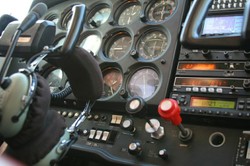Microsoft Flight Simulator is a highly sophisticated program that mimics as closely as possible the physics involved in real world flying. This means that it provides realistic feel and feedback to those users who have the correct control column.
Picture yourself driving down a road when the traffic lights unexpectedly turn yellow. Seeing that you are a safe driver, you decide to slow down well ahead of the lights. You press down on the brake pedal with the amount of force that past experience has told you to use. This time, however, your brakes have been adjusted so that it takes no force to depress the brake pedal. It moves as soon as your foot touches it. If you lift your foot, the pedal rises, but there is no feeling of force pressing against your foot. In this situation, you would brake too harshly, and maybe even cause an accident.
The controls of an aircraft are designed like those of a car. They produce tangible feedback to help the pilot feel the plane so that he can fly it in a smooth and stable manner. The forces that a real pilot feels while holding the yoke increase the more he moves it.
I apologize for the next sentence, which is highly technical.
Yoke force = (trim-speed - airspeed) + (flap setting) + (power setting) + (g-load)
Trim-speed is the airspeed that the plane is trimmed for. There is a trim control that when adjusted perfectly, enables the pilot to take his hands off the yoke. It is comforting to know that pilots don't need to constantly wrestle with the controls during a flight.
There is a rich mixture of forces that a pilot feels on his controls. These won't come as a shock if the student pilot has been using the right yoke and pedal controls with his software.










 The Sherlock Phenomenonon 04/27/2014
The Sherlock Phenomenonon 04/27/2014
 Create Cartoon Animation for Freeon 05/23/2013
Create Cartoon Animation for Freeon 05/23/2013
 Buying a Snooker Tableon 03/18/2013
Buying a Snooker Tableon 03/18/2013
 Snooker and Pool Aiming Techniqueson 02/22/2013
Snooker and Pool Aiming Techniqueson 02/22/2013



Comments